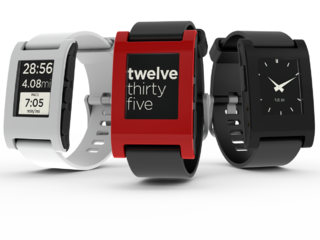
Mobile payment, also referred to as mobile money, mobile money transfer and mobile wallet, is any of various payment processing services operated under financial regulations and performed from or via a mobile device. Instead of paying with cash, cheque, or credit card, a consumer can use a payment app on a mobile device to pay for a wide range of services and digital or hard goods. Although the concept of using non-coin-based currency systems has a long history, it is only in the 21st century that the technology to support such systems has become widely available.

Near-field communication (NFC) is a set of communication protocols that enables communication between two electronic devices over a distance of 4 centimetres (1.6 in) or less. NFC offers a low-speed connection through a simple setup that can be used for the bootstrapping of capable wireless connections. Like other proximity card technologies, NFC is based on inductive coupling between two electromagnetic coils present on a NFC-enabled device such as a smartphone. NFC communicating in one or both directions uses a frequency of 13.56 MHz in the globally available unlicensed radio frequency ISM band, compliant with the ISO/IEC 18000-3 air interface standard at data rates ranging from 106 to 848 kbit/s.

Contactless payment systems are credit cards and debit cards, key fobs, smart cards, or other devices, including smartphones and other mobile devices, that use radio-frequency identification (RFID) or near-field communication (NFC) for making secure payments. The embedded integrated circuit chip and antenna enable consumers to wave their card, fob, or handheld device over a reader at the Point-of-sale terminal. Contactless payments are made in close physical proximity, unlike other types of mobile payments which use broad-area cellular or Wi-Fi networks and do not involve close physical proximity.
Mobile ticketing is the process whereby customers order, pay for, obtain, and validate tickets using mobile phones. A mobile ticket contains a verification unique to the holder's phone. Mobile tickets reduce the production and distribution costs associated with paper-based ticketing for operators by transferring the burden to the customer, who is required to contribute the cost of the physical device (smartphone) and internet access to the process. As a result of these prerequisites, and in contrast to paper-based systems, mobile ticketing does not follow the principles of universal design.

Mobile accessories include any hardware that is not integral to the operation of a mobile smartphone as designed by the manufacturer. Its purpose is to protect the mobile from being damaged or to use for more convenient use of the mobile.

Wearable technology is any technology that is designed to be used while worn. Common types of wearable technology include smartwatches and smartglasses. Wearable electronic devices are often close to or on the surface of the skin, where they detect, analyze, and transmit information such as vital signs, and/or ambient data and which allow in some cases immediate biofeedback to the wearer.

A smartwatch is a portable and wearable computer device in a form of a watch; modern smartwatches provide a local touchscreen interface for daily use, while an associated smartphone app provides management and telemetry, such as long-term biomonitoring. While early models could perform basic tasks such as calculations, digital time telling, translations, and game-playing, smartwatches released since 2015 have more general functionality closer to smartphones, including mobile apps, a mobile operating system, and WiFi/Bluetooth connectivity. Some smartwatches function as portable media players, with FM radio and playback of digital audio and video files via a Bluetooth headset. Some models, called watch phones, have mobile cellular functionality such as making telephone calls.

The Sony SmartWatch is a line of wearable devices developed and marketed by Sony Mobile from 2012 to 2016 through three generations. They connect to Android smartphones and can display information such as Twitter feeds and SMS messages, among other things.

Pebble is a discontinued smartwatch developed by Pebble Technology Corporation. Funding was conducted through a Kickstarter campaign running from April 11, 2012, to May 18, 2012, which raised $10.3 million; it was the most funded project in Kickstarter history, at the time. Pebble began shipping watches to Kickstarter backers in January 2013. Pebble watches can be connected to Android and iOS devices to show notifications and messages. An online app store distributed Pebble-compatible apps from many developers including ESPN, Uber, Runkeeper, and GoPro.

Apple Wallet is a digital wallet developed by Apple Inc. and included with iOS and watchOS that allows users to store Wallet passes such as coupons, boarding passes, student ID cards, government ID cards, business credentials, resort passes, car keys, home keys, event tickets, public transportation passes, store cards, and – starting with iOS 8.1 – credit cards, and debit cards for use via Apple Pay.
Microsoft Pay was a mobile payment and digital wallet service by Microsoft that allowed users to make payments and store loyalty cards on certain mobile devices, as well on PCs using the Microsoft Edge browser. Microsoft Pay does not require Microsoft Pay-specific contactless payment terminals, and supported existing contactless terminals if used on mobile devices. Similar to Android Pay, Microsoft Pay utilized host card emulation (HCE) for making in-store payments.

The Samsung Galaxy Gear is a smartwatch produced by Samsung Electronics in the Samsung Gear family of devices. Unveiled during a Samsung Unpacked event in Berlin, Germany on September 4, 2013, the device serves as a companion for all Samsung Galaxy smartphones and tablets which runs on Android 4.3 "Jelly Bean" or newer. It was released on September 25, 2013. Originally released as an Android-based device, Samsung replaced the operating system with Tizen through the May 2014 software update.

The Metrebus Card is a contactless smartcard ticketing system for Rome. It has stored value on a paper ticket for either 1, 3 or 7 days. All three versions of the tickets look the same on the front, but on the back of the ticket the magnetic data printed on the ticket varies depending on which version of the ticket was purchased.

Wear OS is a version of Google's Android operating system designed for smartwatches and other wearables. By pairing with mobile phones running Android version 6.0 "Marshmallow" or newer, or iOS version 10.0 or newer with limited support from Google's pairing application, Wear OS integrates Google Assistant technology and mobile notifications into a smartwatch form factor. Wear OS is closed-source, in contrast to the free and open-source Android.

Misfit, Inc. was an American consumer electronics company founded on 14 October 2011 by Sonny Vu, Sridhar Iyengar and John Sculley, owned by Fossil Group. It specialized in wearable technology that utilizes sensors and home automation products. Misfit's wearable activity trackers and count sleep, calories, and basic steps that can be synced to a mobile app on a compatible smartphone. Vu and Iyengar previously co-founded AgaMatrix, a company that made the iBGStar, the first FDA approved Smartphone medical device.

Google Pay is a mobile payment service developed by Google to power in-app, online, and in-person contactless purchases on mobile devices, enabling users to make payments with Android phones, tablets, or watches. Users can authenticate via a PIN, passcode, or biometrics such as 3D face scanning or fingerprint recognition.

Mi-Pay is a contactless NFC-based mobile payment system that supports credit, debit and public transportation cards in China. The service was launched by Xiaomi in partnership with UnionPay.

Amazfit is a Chinese smart wearable brand established in September 2015 and headquartered in Hefei. Its products are manufactured and owned by Zepp Health. The brand offers wearable devices including smartwatches, fitness bands, and equipment related to health and sports.
Google Wallet is a digital wallet platform developed by Google. It is available for the Android, Wear OS, and Fitbit OS operating systems, and was announced on May 11, 2022, at the 2022 Google I/O keynote. It began rolling out on Android smartphones on July 18.
















